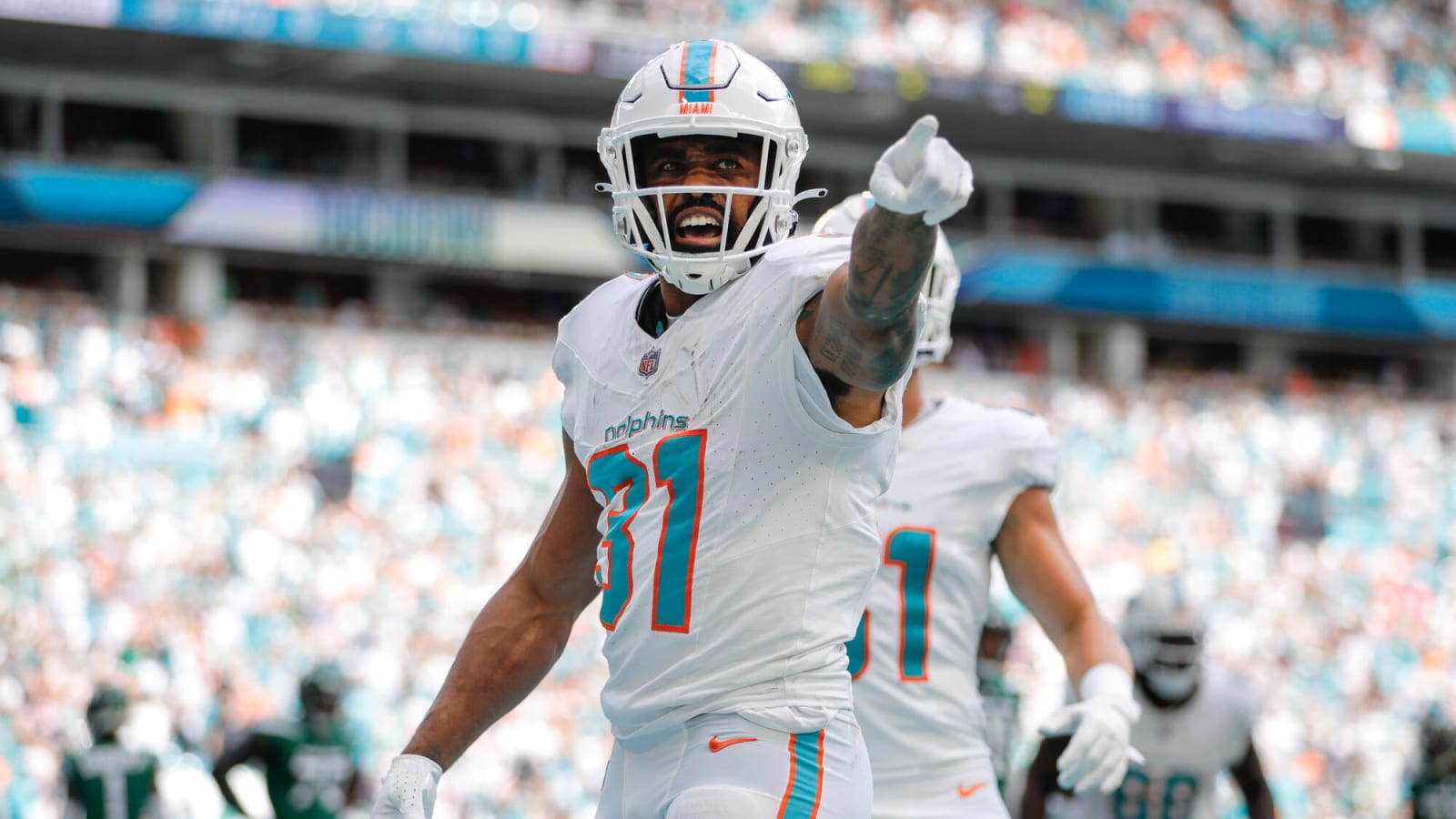
There is no offense quite like the Miami Dolphins. That was true as soon as Mike McDaniel stepped foot in Miami. The offense was a revelation throughout the 2022 season but sputtered toward the end of the year through injuries and a lack of effective changeup. With receivers pressed at the line and the middle of the field taken away, the Dolphins didn’t have a counterpunch to rely on.
That is not the case this season. The passing game has continued to evolve, but the run game has taken the biggest step forward for 2023. It would be unfair to call Miami’s run game a changeup because changeups don’t also get thrown 100 mph.
No team has been more productive of running back rushes this season, and it’s not particularly close. Just four teams have produced positive EPA on running back rushing attempts so far in 2023. The Dolphins are first by more than double the next-highest team, per TruMedia.
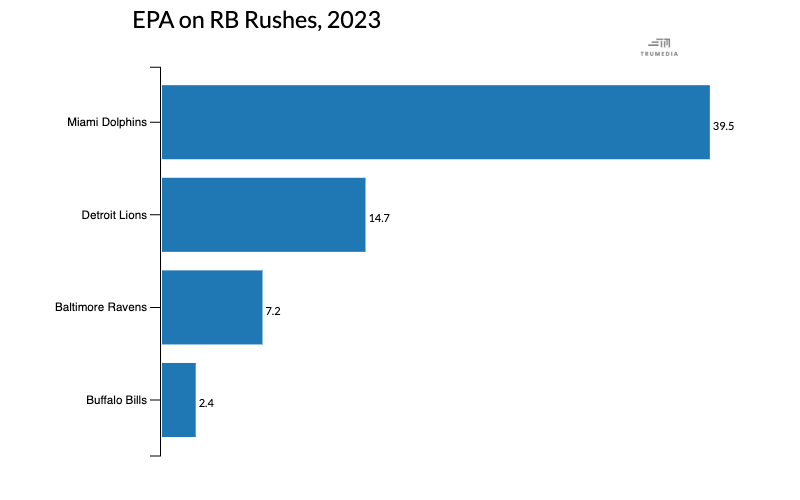
Having an effective run game would be useful enough on its own, but how the Dolphins crafted the rushing attack makes it one of the most dangerous units in the league. Through Week 15, the EPA per play generated by the Dolphins’ run game would be fifth among passing offenses.
Everything for Miami starts with the motion. No team uses motion more often than the Dolphins, who motion on over 80 percent of offensive plays and use motion at the time of the snap over 65 percent of the time, per ESPN Analytics.
The movement pre-snap has opened things up in the passing game, and it’s made life hell for linebackers trying to defend the run, especially when the Dolphins keep the movement and deception going after the snap. Let’s look at a 15-yard run from early in the Week 14 matchup against the Tennessee Titans.
This play was a second-and-7 from Miami’s 15-yard line. The Dolphins came out in 21 personnel, but the two backs were Raheem Mostert and De’Von Achane. It also wasn’t a typical 21 personnel alignment. Tyreek Hill was lined up inline, where he’s been for 1.9 percent of snaps this season per TruMedia, and Achane was in a tight split outside of him.
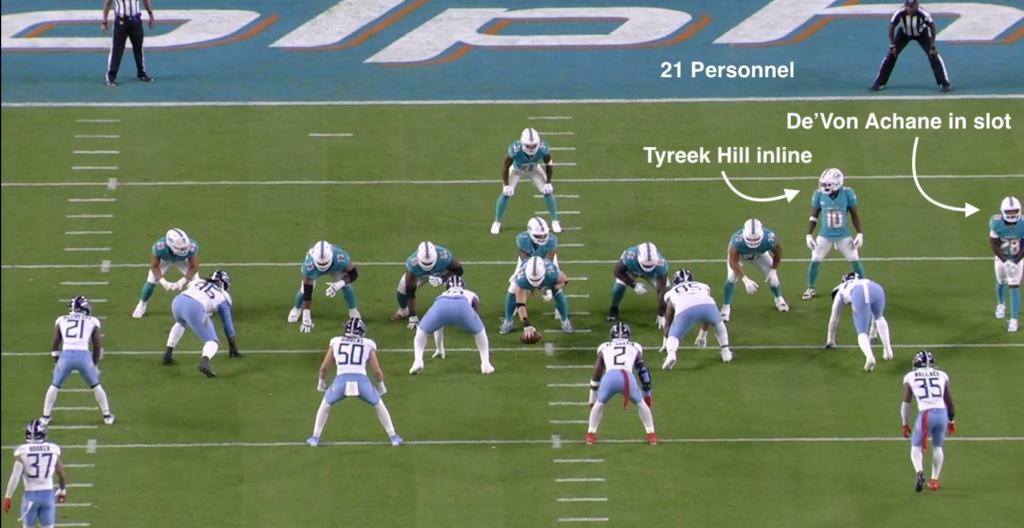
Before the snap, Hill motioned across the formation, which pulled both linebackers toward him.
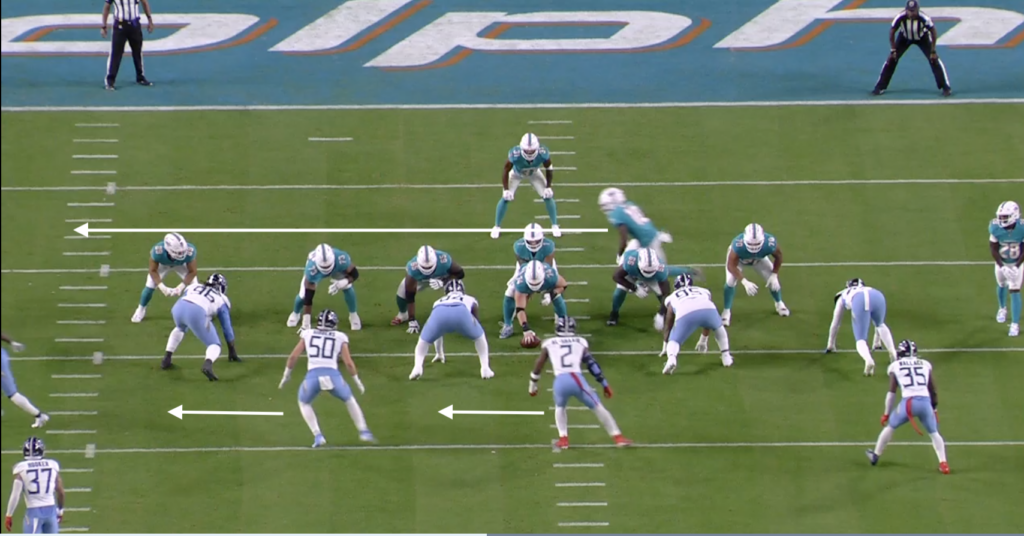
The ball was snapped while Hill was still in motion, and it got more chaotic from there. The right guard pulled to take on the unblocked edge on the left side. The left guard snuck out to the second level on the right, and after the right tackle got in a block on the defensive tackle in front of him, he also got out to the second level.
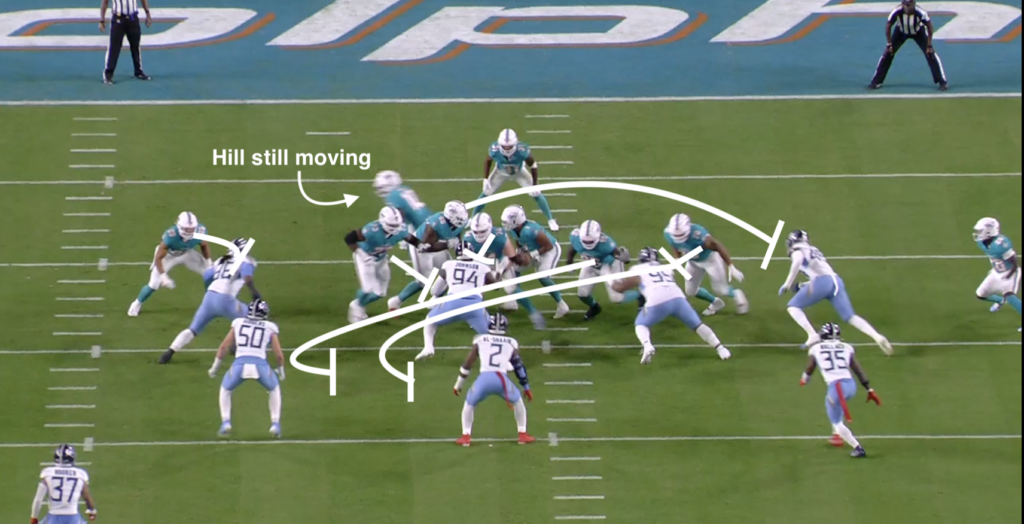
With all that going on, Tua Tagovailoa faked a handoff to Mostert going to the left side. That caught the eyes of the linebackers, which caused them to sway that way. Meanwhile, Achane started his path into the backfield.
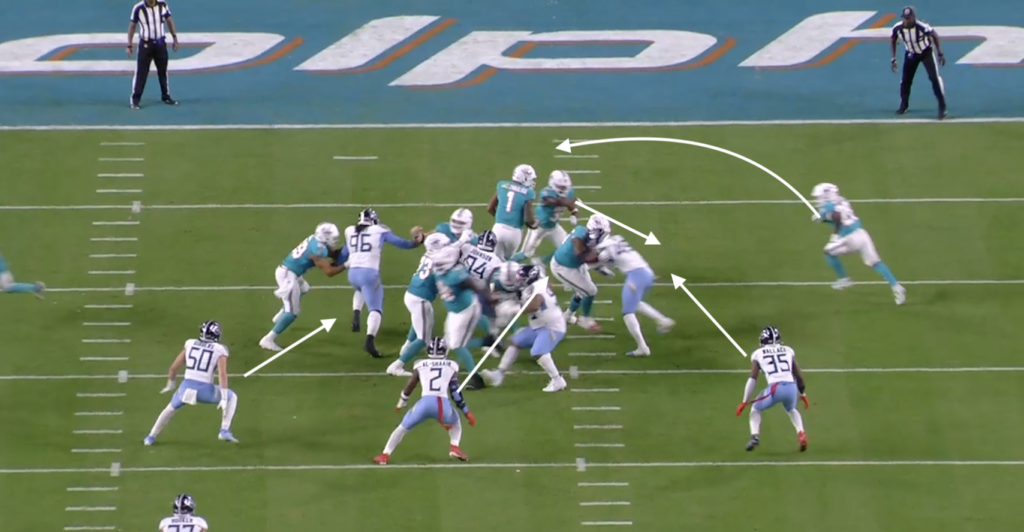
When the ball was flipped to Achane, the linebackers were still stuck watching the backfield and drifted into the middle of the field. Linebackers have routinely been put in this position watching the Dolphins offense. Miami disguises ball carriers like a ball under one of three cups, and the defenders consistently have to watch and guess where it is.
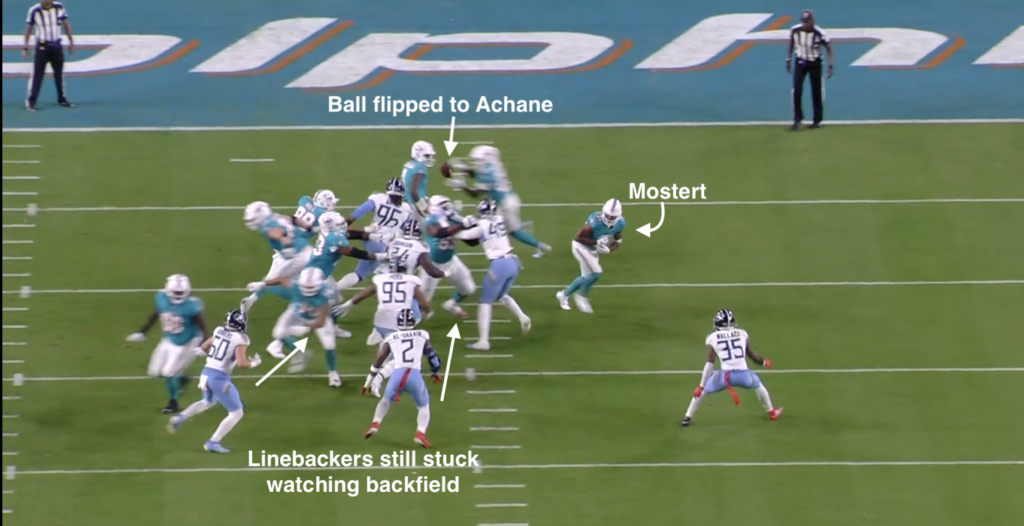
By the time the second-level defenders were able to react to who had the ball, the offensive linemen were out in the open field and ready to build a wall, and there was a ton of running room for Achane.
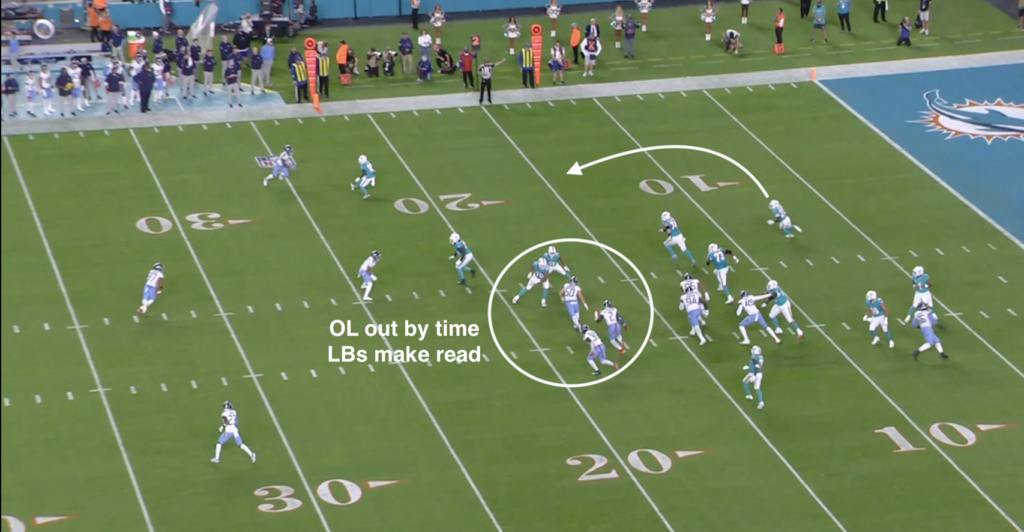
Achane was first contacted eight yards past the line of scrimmage and stumbled another seven yards before going down. That’s the goal for these types of runs. The design creates space for fast backs like Mostert and Achane and eliminates most of the danger of getting stuffed behind the line.
It’s even more dangerous when the Dolphins put those two backs on the field together, like the play above. Many teams love the idea of Pony personnel (two running backs on the field instead of a running back and fullback), but it’s better in theory than practice. Typically, having that extra running back on the field compacts the playbook.
That hasn’t been the case for the Dolphins, especially in the run game. Miami has 13 rushing attempts with both Mostert and Achane on the field. The Dolphins have gained 152 yards — 11.7 yards per rush on those plays. Those plays average 0.78 EPA per play with a 76.9 percent success rate. Six of those 13 runs (46.3 percent) have gone for at least 10 yards, and three have gone for at least 20. It’s a small part of the Miami run game, but it makes a difference and could continue to have a bigger impact into the playoffs with both backs healthy.
Opposing defenses must respect the speed of the backs and the receivers constantly moving around. That often gives Miami favorable run looks, even when they’re in heavier personnel.
No team has more rushing attempts this season than the Dolphins, with 190. While that occasionally means the Pony packages, it more often comes with fullback Alec Ingold on the field. When offenses go heavy, defenses typically go heavy in response, which also means a loaded box.
But with all the speed on the field for the Dolphins and how they align it, it’s difficult for defenses to throw big bodies into the middle of the field to stop the run. Just 19.5 percent of Miami’s rushing attempts from 21 personnel have gone into a defensive box of eight or more men.
The average from 21 personnel this season is 41.2 percent, per TruMedia. The San Francisco 49ers, who are similar to the Dolphins in personnel versatility, run into a loaded box on 19.5 of their rushing attempts from 11 personnel. The Niners see a loaded box on 55.6 percent of their 21 personnel runs.
With advantageous box counts and an offensive line that has been in sync while run blocking (they rank sixth in run block win rate per ESPN, despite ranking 29th in pass block win rate), it’s allowed the Dolphins to avoid negative runs that put them behind the chains.
Few rushing offenses have been this explosive in the modern era without trading those big runs for negative plays. Since 2000, there have only been four teams to have an explosive run rate more than 14 percent and a stuff rate under 15 percent on running back attempts — those teams are the 2000 St. Louis Rams, 2020 Minnesota Vikings, 2021 Cleveland Browns, and 2023 Dolphins.
Since the Dolphins can often manipulate the line of scrimmage, either by deception or just good run blocking, Miami is fifth in yards before contact per rush. With space to run and allowing backs like Mostert and Achane to pick up speed, the Dolphins also thrive in bouncing off defenders and creating yards after contact, where they’re first as a team by a wide margin.
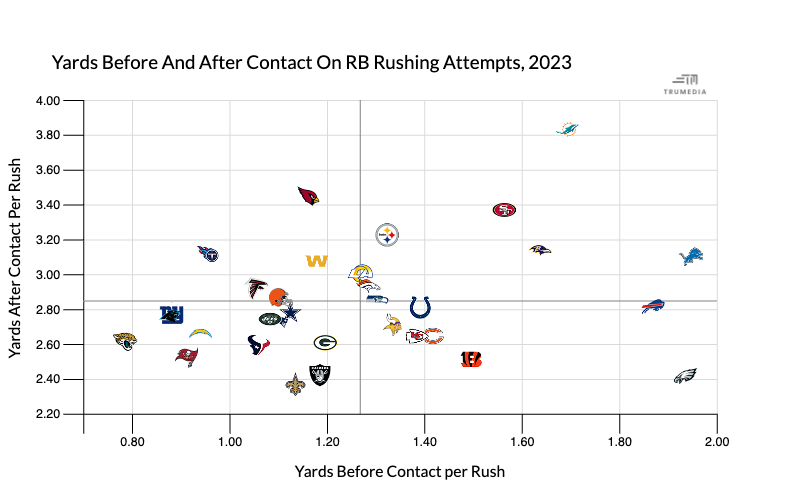
This is still the case when the field compacts in the red zone. The Dolphins have the sixth-highest run rate in the red zone, but they can still create open running lanes. They’re third in yards before contact per rush (1.1) and fifth in yards after contact per rush. They have a 67.6 percent rushing success rate in the red zone, while no other team has hit 60 percent. Just five others are over 50 percent.
Miami has turned this running game into a legitimate weapon to help sustain drives and win games. The Dolphins can run in any situation on any down, and they’re just as likely to spring for a big play as they are when they throw. It’s the biggest difference between what the Dolphins were at this time in 2022 and what they are as an offense now. Add in a defense that’s improved since the return of Jalen Ramsey, and this could be considered one of the most complete teams in the league.
It’s hard to stop this Miami offense, and the Dolphins have made it a point to run right past those who have tried.
More must-reads:
- Reporter provides noteworthy injury update on Ravens QB Lamar Jackson
- Draft guru shares advice for young quarterbacks after Anthony Richardson benching
- The 'Sack leaders by NFL franchise' quiz
Breaking News
Customize Your Newsletter
 +
+
Get the latest news and rumors, customized to your favorite sports and teams. Emailed daily. Always free!
